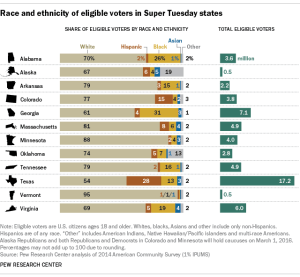

The nation’s largest annual demography conference, held in Washington, D.C., last week, featured new research on topics including couples who live in separate homes, children of multiracial couples, transgender Americans, immigration law enforcement and how climate change affects migration. Here is a roundup of five of the many innovative posters and papers from the Population Association of America meeting, some based on preliminary work. They give insight into the questions on researchers’ minds. (To see the conference presentations by our own Pew Research Center experts, check out this page.)
Living Apart Together
As marriage declines in popularity and other kinds of relationships replace it, a category of couple known as Living Apart Together is the focus of new research in the U.S. These LAT couples, whether opposite-sex or same-sex, say they are in a long-term relationship but do not live together. They include older couples who each own homes as well as people who work in different cities. There’s been some research on these LAT couples in Europe, but until recently, less in the U.S.
Susan L. Brown and other scholars at the National Center for Marriage and Family Research at Bowling Green State University in Ohio presented their findings about Americans in this group. Using survey research company GfK’s Knowledge Panel (a large-scale online panel based on a representative, probability-based sample of the U.S. population), they estimate that up to about 40% of adults in dating relationships are Living Apart Together. They classified people in dating relationships as LAT couples if they agreed or strongly agreed with this statement: “Nowadays, many couples are in a committed, long-term relationship and choose to live apart (maintaining separate residences) rather than cohabit or marry. This describes my current relationship with my dating partner.”
When the researchers analyzed the characteristics of LAT couples compared with other people who were dating but didn’t agree with the statement above or were neutral about it, they found that LAT couples are older – about half are 35 or older, compared with only 30% of daters. They suggest that people in LAT relationships are more likely to have been previously married, and to own homes, perhaps in part because they are older. The racial-ethnic profiles of the two groups did not appear to differ. As might be expected, most LATs said it was very unlikely, unlikely, or that they did not know whether they would marry; most other daters said it was very likely or likely they would marry their partner. “LAT relationships are gaining momentum among middle-aged and older adults who may have less to gain from cohabitation or marriage,” the researchers said.
Children of multiracial couples
When two people of different races have a child together, how do they choose to identify the race of their child on census forms? Carolyn A. Liebler and José Pacas of the University of Minnesota analyzed U.S. census data from 1960 to 2010 – a period of dramatic rise in interracial marriage that has resulted in a corresponding growth of the multiracial population. Since 1960, Americans have been allowed to choose their own race on census forms, rather than having enumerators do it for them. Although the census form did not offer people the opportunity to check more than one race box until 2000, the researchers found that some did so as early as 1980.
Their research found that not all interracially married parents checked more than one race box for their young children. Different groups varied in their responses, too. Some factors mattered in how parents did report race: Interracial couples living in the West, the region with the largest Asian and Pacific Islander population, were more likely to report their child is Asian and Pacific Islander, alone or in combination with another race. A child of a white or black male householder was more likely to be reported as the same race as the father.
But other factors, such as whether a parent is Hispanic (an ethnic category, not a race), didn’t make a consistent difference, the researchers found. In general, the share of married people living in a census tract who have mixed-race marriages is not linked to how the child’s race is reported.
Sexual orientation and gender identity
The rise of legal same-sex marriages, headlines about hate crimes and concerns about potential differences in health have been among the factors driving increased interest in gathering better data about gay, lesbian and bisexual Americans, as well as those who are transgender. (This work includes our own survey in 2013.) This week, several dozen members of Congress urged lawmakers to pressure the Census Bureau to expand its data collection about people who identify with these groups.
A growing wave of research is happening, or on the way, according to presentations at a session on new ways of gathering data on sexual orientation and gender identity. In the past five years, 10 federal agencies have collected data about sexual orientation, and five about gender identity, but not all questions were worded the same, according to information gathered by a federal interagency working group.
In July, the National Crime Victimization Survey will begin asking survey respondents ages 16 and older about their sexual orientation and gender identity. The survey, fielded by the Bureau of Justice Statistics, includes 90,000 households a year. The new data will provide information about victimization risks for these groups, and about their access to victim services. But statistician Jennifer L. Truman cautioned that these groups are so small that there may not be a large enough sample to report annual statistics.
The California Health Interview Survey added test questions about gender identity in 2014, and incorporated the ones that worked best in 2015. Adding these questions to a survey did not generally anger respondents or confuse them, said Matt Jans of UCLA’s Center for Health Policy Research. People did not break off interviews, for example, because they were upset about being asked about their sexual orientation or gender identity.
Unauthorized immigration
State laws enacted over the past decade requiring employers to verify that all new hires were eligible to work apparently led to a reduction in the unauthorized immigrant population in those states, according to research by Pia Orrenius of the Federal Reserve Bank of Dallas and Madeline Zavodny of Agnes Scott College. They believe these laws cause some unauthorized immigrants to leave the U.S., especially those who recently arrived, although they had no direct evidence. Meanwhile, the number of newly arrived unauthorized immigrants rose in nearby states, apparently because new arrivals avoided states with E-Verify laws. The researchers said, however, that they did not find evidence that many unauthorized immigrants left an E-Verify state for another state.
In 2007, Arizona was the first state to pass such a law, which requires all employers to use the free online federal E-Verify system. Six other states in the South or Southwest later did so: Alabama, Georgia, Mississippi, North Carolina, South Carolina and Utah. (Other states passed laws covering only government workers and contractors, but the paper did not analyze those.) Earlier research had found that tougher enforcement laws, including E-Verify, may have been linked to lowered employment and earnings for unauthorized immigrants and that Arizona’s law may have reduced its unauthorized immigrant population.
The new paper used 2005-2014 data from the Census Bureau’s American Community Survey, and was based on a rough, incomplete definition of an unauthorized immigrant – noncitizens ages 20-54, with at most a high school education, from Mexico or Central America. (The estimates by Pew Research Center, which include the entire unauthorized immigrant population, differ from the ones used in this paper.) The researchers said their findings accounted for the recent stepped-up pace of deportations and other factors that might raise or lower unauthorized immigrant numbers.
Climate change and migration
The role of climate change in predicting future migration was the topic of a paper that looked at whether rural Mexican immigration to the U.S. would rise after a drought or long heat wave. Two researchers from the University of Minnesota, Raphael J. Nawrotzki and Jack DeWaard, reported that households initially try to stay where they are and cope with the impact of climate events such as extreme heat waves or droughts, but that migration levels then rise over the next three years before declining.
The researchers said their work accounted for other factors, such as financial need, that might cause people to migrate. They based their research on U.S. government temperature and precipitation records, as well as data collected by the Mexican Migration Project, a survey done in four to six Mexican rural communities each year since 1982. Their work covered 1986-1999, a period of rising Mexican immigration to the U.S. More recently, Mexican immigration to the U.S. generally has leveled off or decreased.
It’s already widely known that drought and temperature increases both are linked to increased emigration. Their new paper, the researchers said, adds the element of timing, to show that programs to help farmers and others cope with climate change will work best if put in place quickly, before climate-induced migration begins to rise.
